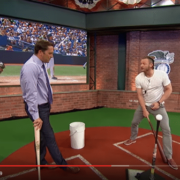Pitch Selection Mastery: How Groundball Hitters and Flyball Pitchers Are Quietly Reshaping MLB Strategy

Flyball Hitters Love Sinkers? The Unseen Flaws in MLB’s Pitching Playbook
Major League Baseball (MLB) is always changing, with new strategies and player development making a big impact. The rise of groundball hitters and flyball pitchers is a big change that’s affecting team strategies and success. Data shows that more players are using these specialized approaches. Groundball hitters like Thomas Saggese of the St. Louis Cardinals did well with a .306/.374/.530 line and a 22.9%/8.3% strikeout to walk percentage. Flyball pitchers like Sonny Gray of the Cardinals also shone with a 2.79 ERA and 24.5%/7.3% strikeout to walk percentage.
Key Takeaways
- The rise of groundball hitters and flyball pitchers is quietly reshaping MLB strategies.
- Groundball hitters like Thomas Saggese are finding success with a focus on contact and situational hitting.
- Flyball pitchers like Sonny Gray are finding success by effectively utilizing sinkers and four-seamers to generate groundballs and barrel misses (swinging under).
- Understanding the evolving trends in pitch selection and batted ball profiles is crucial for teams to stay ahead of the curve.
- Advanced analytics and data-driven decision-making are playing a pivotal role in shaping these emerging strategies.
We’ll explore how groundball hitters and flyball pitchers are changing the game. By looking into the details, we can see what’s driving these changes. This gives us insights into the future of MLB strategies.
The Rise of Groundball Hitters
In Major League Baseball, a new type of hitter is gaining attention – the groundball specialists. Triston Casas, a star with the Boston Red Sox, is a great example. He uses a low launch angle for consistent, hard contact, resulting in many groundballs.
Analyzing Casas’ Batted Ball Profile
Casas’ stats show his skill at the plate, like his high exit velocity and precise spray charts. He focuses on making solid contact, not just hitting far. This approach, along with his low launch angle, makes the most of his groundballs, especially in parks like Fenway.
Players like Casas are changing how we see hitting in baseball. They use their skills to hit hard and keep the ball low, offering new strategies for success.
Casas shows how baseball is evolving, moving beyond just hitting home runs. By focusing on discipline and making solid contact, he and others are finding new ways to succeed at the plate. And at the end of this article, you’ll discover it’s a strategy we’ve been using with our hitters over the past 8 years.
Pitch Selection for Groundball Hitters
For groundball hitters, picking the right pitches in the right locations is key to getting on base and scoring more runs. The up fastball is a common choice, but knowing the patterns of other pitches can help you swing better.
Simply observing the pitcher, his throwing patterns, pitch sequences, and tendencies can show you the best pitches to aim for. This helps you find pitches like the two-seam fastball or curveball that can work well for you, depending on the location. This way, you can hit more often and get on base.
Knowing when to swing and understanding your swing path is also vital, or when to change the swing path. Focus on where the pitcher tends to throw and what he throws for strikes to hit better pitches and get more walks. This strategy can make you more confident and improve your hitting.
Some pitches like sinkers, curves, and changeups located down in the zone are great for flyball hitters (who swing up), and not so much for groundball hitters (who swing down). By knowing which pitches are likely to result in ground balls, you can hit them better by swinging UP. This knowledge can help groundball hitters get on base more often.
Groundball hitters should keep working on their pitch selection, using data and understanding their swing and when to make adjustments to their barrel path. This approach can make you a key player in your team’s offense.
The Resurgence of Flyball Pitchers
Baseball has changed, and flyball pitchers are back in the spotlight. They use up fastballs like sinkers and four-seamers to make more fly balls. This change has made flyball pitchers better at striking out up swinging batters and preventing hard hits.
Sinkers and Four-Seamers for Flyball Hitters
Sinkers and four-seamers are key for flyball pitchers. They aim for the upper strike zone to get more swings and misses, leading to more strikeouts. These pitches also make more fly balls, which means fewer hard-hit grounders and line drives.
These strategies are paying off. The average flyball rate is about 28%, and those who throw over 35% flyballs are considered extreme. When these pitchers face flyball hitters, the game gets more exciting with more home runs, but also lead to more swing and misses and strikeouts.
“Verifying assumptions through statistical analysis is crucial in making strategic decisions in the baseball game.”
Teams need to keep up with the game’s changes. Understanding how sinkers and four-seamers located up in the strikezone work against flyball hitters helps coaches make better decisions.
The rise of flyball pitchers shows how baseball keeps evolving. As hitters change their swings, pitchers must adapt to stay ahead. With smart use of data, flyball pitchers will continue to shape the game.
Analyzing Pitching Metrics
Baseball is changing, and so is how we look at pitching. Now, we use ERA, WHIP, FIP, xFIP, and SIERA to see how well pitchers do. These numbers give us a full picture of a pitcher’s skills, going beyond old stats that can be swayed by things not in a pitcher’s control.
Looking closer, Statcast data has changed how we judge pitchers. It uses advanced math to predict what will happen in a game, looking at many factors like the pitcher and batter, the type of pitch, speed, spin, and more. This info helps teams pick the best pitches and develop players better.
Also, different pitches like fastballs and curveballs have their own models to check their quality. These models give a clearer view of a pitcher’s skills, especially when looking at small samples, unlike old stats that can be tricky.
Teams rate pitchers on a 20-80 scale, with 50 being average. Moving up or down by 10 points means a big change in skill level. This helps teams decide on developing pitchers, using them in games, and building their teams.
As baseball changes, using advanced stats and Statcast data will be key to the game’s future. Learning about these metrics can give teams and players an edge.
“Advanced analytics and Statcast data are changing how we look at and improve pitchers. It’s not just the old stats anymore – we’re getting deeper into pitch quality, effectiveness, and how to make pitching strategies better.”
Conclusion
Looking into Major League Baseball, I see how groundball hitters and flyball pitchers are changing the game. Analyzing the data shows us new trends in hitting and pitching. It also highlights the role of advanced analytics.
You may be thinking, Joey, does hitters have to be only a groundball or flyball hitter? NO! I teach my hitters, your approach will be determined by observing the pitcher. If you’re facing a ‘flyball pitcher’, or one that lives up in the zone (or in), then you will become a ‘groundball hitter’. And the opposite is true, if you’re facing a ‘groundball pitcher’, or one that lives down in the zone (or away), then you’ll become a ‘flyball’ hitter.
And on the other hand, if you’re a pitcher, my teams will observe hitters’ swings and that will determine how we attack them. Swing down hitters, we pitch them down. Swing up hitters, and we pitch them up. I tell my defense, if our pitchers do their job today, then they’ll see a lot of flyballs – providing we’re facing swing up hitters. It’s crazy how predictable those games are.
As baseball changes, I’m excited to see how groundball hitters, flyball pitchers, and pitch selection will influence the sport. By keeping up with research and data, we’ll understand the strategic changes in MLB better.
FAQ
What is the main focus of this article?
This article looks at how MLB is changing. It talks about groundball hitters and flyball pitchers making the game different.
How does the article analyze the case of Boston Red Sox prospect Triston Casas?
The article talks about Casas’ hitting skills. He hits hard and often keeps the ball low, which leads to many groundballs. This shows how hitting like this can work well, especially in places like Fenway Park.
What is the importance of pitch selection for groundball hitters?
Groundball hitters are effective at pitches up in the zone because they swing down or have more of a low launch angle. They use charts and stats to find the best pitches. Knowing how to recognize pitches up helps them hit well.
How are flyball pitchers leveraging their fastballs?
Flyball pitchers use sinkers and fastballs up in the zone to get more fly balls. This helps them strike out batters and limit hard hits.
What key pitching metrics are shaping decision-making in MLB?
Teams use stats like run value and exit velocity to check how pitchers do. They look at launch angle, groundball rate, and strikeout rate too. These stats help teams plan their pitching strategies better.
- Fix Late Swings Fast: 2025 Pitch Recognition & See-Decide-Swing Training for Youth Baseball Power Hitters - October 6, 2025
- Safe Youth Weighted Bat Training: Proven Overload/Underload Drills to Increase Exit Velocity in Games Starting Tonight - September 29, 2025
- AI Coaching Course 2025: Youth Baseball & Softball Practice Plan + Off-Season & In-Season Workout Builder Fast - September 23, 2025






